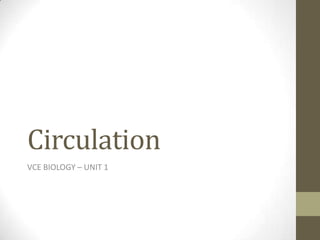
Circulation (bd)
- 1. Circulation VCE BIOLOGY – UNIT 1
- 2. The Heart The biological pump
- 3. UNoxygenated blood enters the atrium on the right side of the heart. Unoxygenated blood comes in from the top of the body through the superior vena cava. Unoxygenated blood comes in from the lower body though the inferior vena cava.
- 4. While the unoxygenated blood is in the right atrium, the tricuspid valve is closed to keep the blood from flowing down to the ventricle.
- 5. The atrium contracts and the tricuspid valve opens, forcing the blood down into the ventricle.
- 6. The tricuspid valve closes again so that blood cannot move back up into the atrium.
- 7. The ventricle contracts. This forces the unoxygenated blood through the pulmonary valve and into the pulmonary arteries.
- 8. The right pulmonary artery takes the unoxygenated blood to the right lung. The left pulmonary artery takes the unoxygenated blood to the left lung. THE PULMONARY ARTERIES ARE THE ONLY ARTERIES THAT CARRY UNOXYGENEATED BLOOD.
- 9. In the lungs, the carbon dioxide in the blood diffuses into the alveoli. The oxygen in the lungs diffuses into the blood. This is called gas exchange. http://www.webmd.com/hw/health_guide_atoz/tp10237.asp
- 10. Oxygenated blood from the lungs enters the heart through the left atrium. The mitral valve is closed to keep the blood from going into the ventricle.
- 11. Oxygenated blood from the right lung returns to the heart through the right pulmonary vein. Oxygenated blood from the left lung returns to the heart through the left pulmonary vein. THE PULMONARY VEINS ARE THE ONLY VEINS THAT CARRY OXYGENATED BLOOD.
- 12. The left atrium contracts. This forces the oxygenated blood through the mitral valve into the right ventricle.
- 13. The mitral valve closes again. This keeps the oxygenated blood from moving back up into the atrium.
- 14. Oxygenated blood is forced into the aorta to be carried to the rest of the body.
- 15. Oxygenated blood is carried to all body cells where oxygen diffuses into the cells and carbon dioxide diffuses into the blood. Blood carrying carbon dioxide then returns to the heart.
- 16. And the cycle begins again.
- 18. Blood Vessels
- 19. Blood Vessels: Arteries, Veins, and Capillaries Arteries and arterioles have a layer of smooth muscle tissue which allows them to contract (vasoconstrict) and expand (vasodilate), altering their diameter and thus blood flow. Walls of arteries and arterioles have many elastic fibers enabling them to withstand high pressures.
- 20. Artery and Vein Artery Vein Note the much thinner walls in veins.
- 23. Haemoglobin Chemical – protein Binds to oxygen to carry oxygen around the body. When oxygen is bound to it, it is called oxyhaemoglobin.
- 25. Circulatory Systems For larger or more active animals, some form of more efficient circulatory system is necessary for internal transport. • Two types of circulatory system are found: Open Circulatory Systems Closed Circulatory Systems
- 26. Open Circulatory System • Hemolymph leaves the heart in short, branched arteries that open up into large spaces called sinuses. • Hemolymph percolates around organs, directly bathing the cells. • Hemolymph then returns to the heart directly or through short veins.
- 27. Open Circulatory System • Advantage - Exchange of materials is direct between the hemolymph and tissues. There is no diffusion barrier. • Disadvantage - Little fine control over distribution of the hemolymph to body regions. No mechanism for reducing flow to a specific part of an organ.
- 28. Open Circulatory System • Open circulatory systems tend to be found in more inactive animals. • Most molluscs have an open system, but the highly active cephalopods (squid and octopus) have evolved a closed system. • Insects have circumvented limitation of their open system by their tracheal system for oxygen supply.
- 29. Closed Circulatory System • The blood is contained within a completely closed system of vessels. • Vessels form a closed loop, usually with some sort of pumping organ like a heart or contractile vessels. • Vessels branch into smaller and smaller tubes that penetrate among the cells of tissues.
- 30. Closed Circulatory System Advantages: • Fine-scale control over the distribution of blood to different body regions is possible. • Muscular walls of vessels can constrict and dilate to vary the amount of flow through specific vessels. • Blood pressures are fairly high and the circulation can be vigorous.
- 31. Human Circulatory System A Closed Circulatory System
- 32. How does this system work? pulmonary vein lungs pulmonary artery head & arms aorta main vein Right Left liver digestive system kidneys legs Circulatory System
- 33. Our circulatory system is a double circulatory system. This means it has two parts parts. Lungs the right side of the left side of the system the system deals with deals with deoxygenated oxygenated blood. blood. Body cells